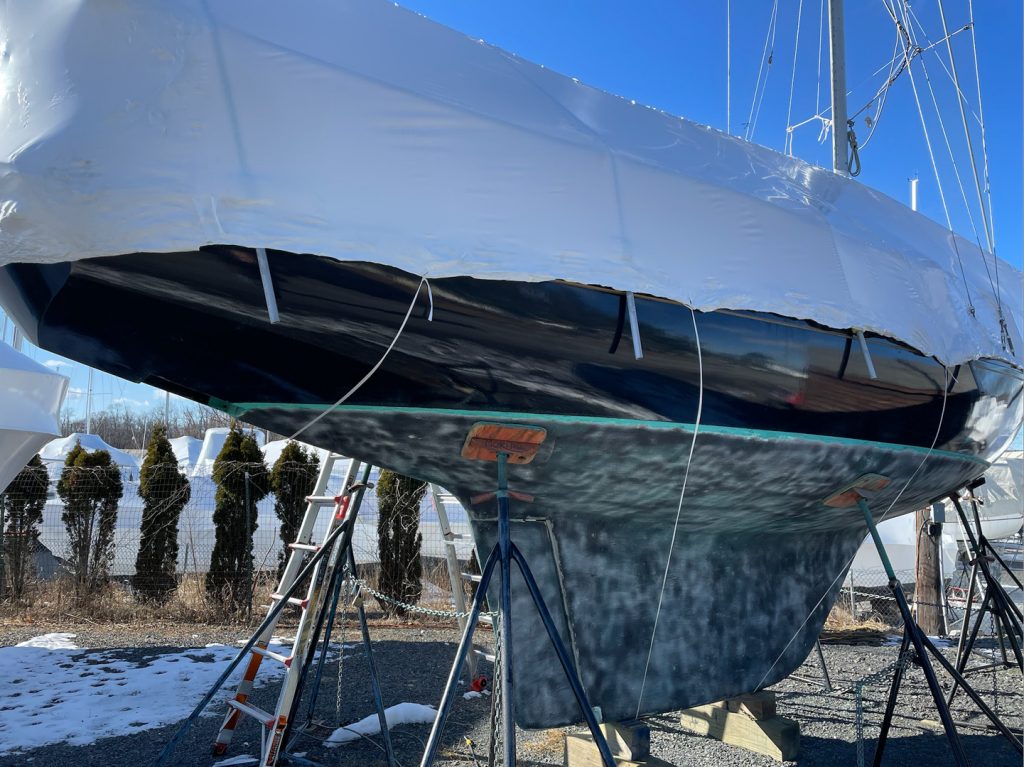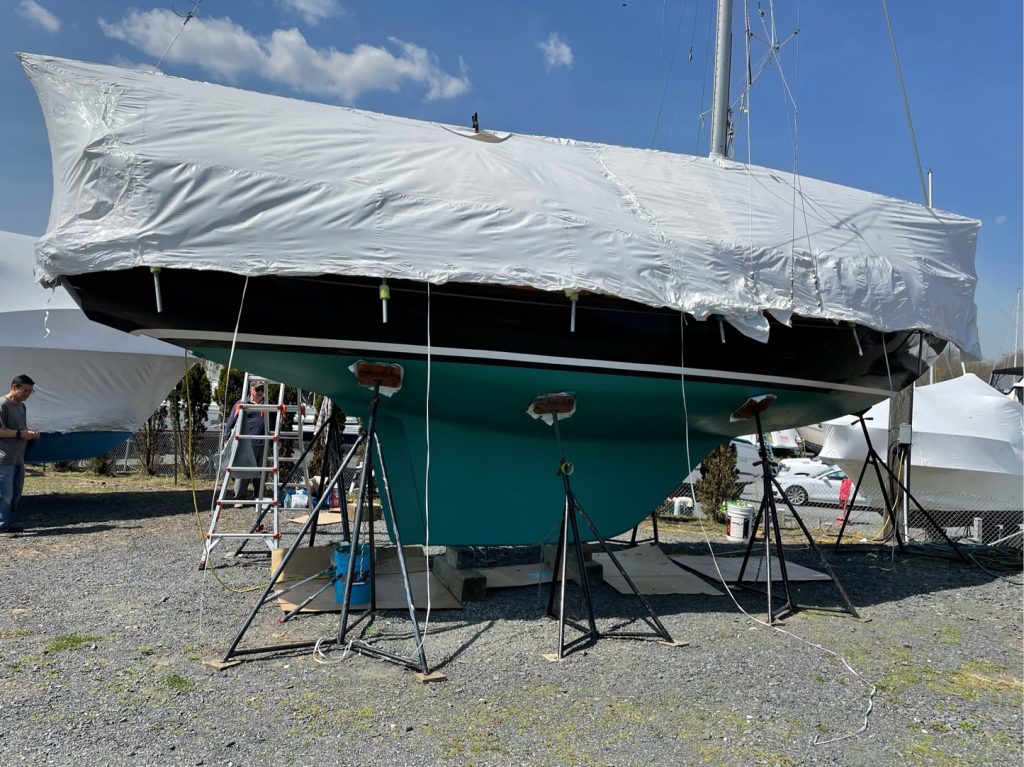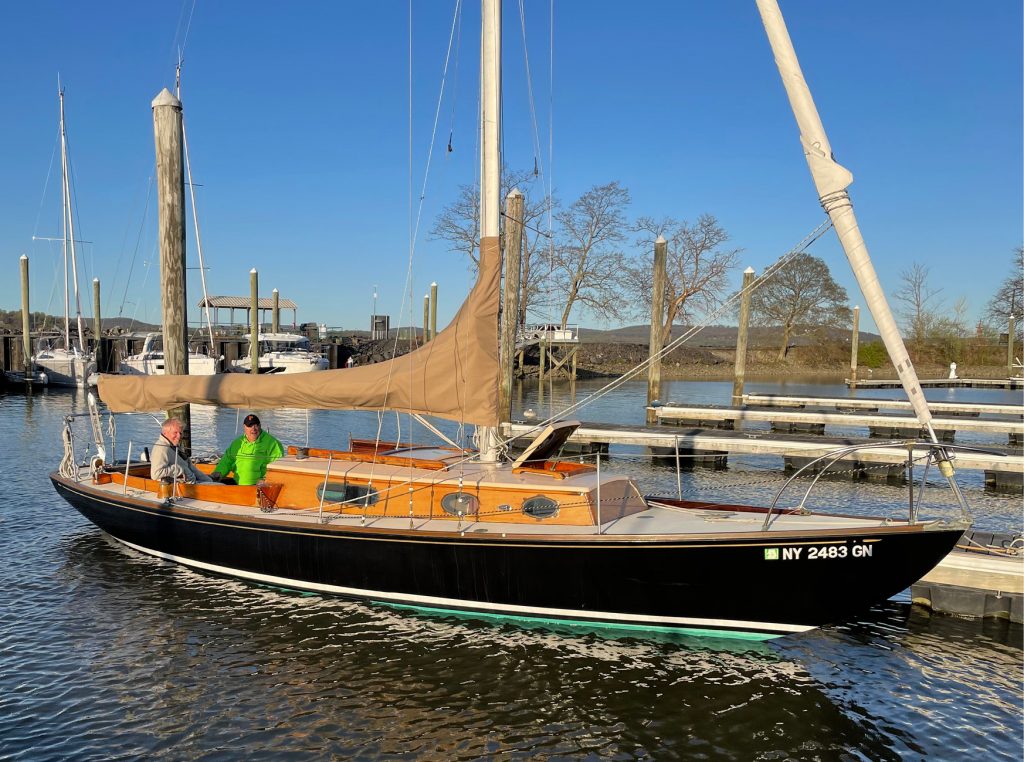By Paul Jacobs & Tom McDonald
The Discovery
Last October, after a splendid autumn sail on our 1990 Catalina 34 Pleiades, my wife Nancy and I returned to her mooring in Wickford Harbor, Rhode Island had some nice wine and cheese in the cockpit, cleaned up, and departed the mooring in our dinghy. Taking the usual track back to NorthWick Marina, I happened to spot a lovely sailboat to starboard that I had not noticed before. I told Nancy that I would like to look at it from a closer vantage point. She agreed, I altered course, and our lives soon changed without knowing it!
On drawing nearby I thought, “What a classic little sailboat,” with a really gorgeous shear line, substantial overhangs at both the bow and the stern, a simple narrow shape, and an elegant overall look. Just as I started to slowly circle around her, a head popped out from below. It was the owner. I asked, “What is this lovely little sailboat? It looks a bit like a Herreshoff, but I actually don’t think so.” She replied, “Many people assume that, but no, she is a Graves Constellation.” I circled around twice, telling the owner how lovely her lines were and also asking how she sailed. Her response was, “Thank you for your kind comments, and she is a joy to sail with just two fingers on the tiller in fifteen knots of wind.”

The 1964 Graves Constellation, with a freshly bead-blasted bottom, on the hard at the Minisceongo Yacht Club in Stony Point, New York
A week later I happened to be speaking to my old friend and former boat partner, Tom McDonald, when I related the above story. I did not think about it very much after that. I am now 83. Sadly, close tacking our C-34 in the narrow portions of the East Passage of Narragansett Bay when the wind is above 12 knots leaves me panting, so Nancy and I reluctantly decided Pleiades was perhaps getting to be a bit too much. Rather than sell her, we will give her to our son and daughter-in-law and their three boys – ages 8, 6 and 3. However, even the prospect of my being without a sailboat for the first time in fifty years was profoundly sad.
Then, a few months later, in January 2022 “out of the blue” Tom called me back and said, “I found a Graves Constellation for sale at a very fair price.” I said, “Tell me more” and he did. It all sounded reasonable, and the boat was in Stony Point, New York. I was born in New York City, raised on Long Island, and went to college in upstate New York, but had never heard of Stony Point. A quick check of Google revealed that Stony Point is about 10 NM north of the Tappan Zee Bridge, on the west bank of the Hudson River. Being January it was rather cold outside, but it was sunny and not snowing, so I said to Tom, “How about driving there – roughly 200 miles from Rhode Island one way, and another 200 miles back again, all in one day?” Tom said his calendar was clear, so he called the owner and made an appointment to see the 1964 Graves Constellation the next day. We left Warwick at about 8:30 am, and arrived at the Minisceongo Yacht Club around noon, met John Moreno, the owner, and started looking at his venerable sloop.
A bit of highly ironic background: Nancy was born in Newport, Rhode Island but at age 3 her family moved to Marblehead, Massachusetts where she grew up, learned to swim in truly chilly water, and also to sail at an early age. In her teens she and her sister raced 110s, some of which were built in the Graves Yacht Yard in Marblehead, only a mile from her childhood home! In fact, Graves was one of the earliest yards to build in fiberglass. Unfortunately, back in 1964 there were still no fiberglass hull scantlings available, as Lloyds of London was attempting to determine how thick a fiberglass hull needed to be to survive the stresses of sailing in the open ocean. Consequently, for some of the earliest fiberglass hulls the philosophy seems to have been, “When in doubt, build it thicker and stronger.” Whereas most un-cored fiberglass hulls, such as Pleiades, are about one centimeter thick, the Graves Constellation hulls are about an inch thick!
Furthermore, John had decided to bead-blast the bottom to remove years of accumulated bottom paint. Since the boat was on the hard, Tom and I had a splendid opportunity to closely inspect her bottom, which was in really excellent condition – not a crack, divot, or blister in sight. While her hull is fiberglass, her deck is fiberglass-coated marine plywood, and her coach siding, frames and coaming are all mahogany. Inspection of the cockpit and coach interior showed that everything was fundamentally sound, but proper restoration would require much stripping, scraping, sanding, sealing, and either varnishing (mahogany) or priming and painting (fiberglass overheads, ceilings, and V-berth and salon sleeping platforms, and bulkheads).

The GC sporting a new white bootstripe and green ablative bottom paint
Fortunately, both Tom and I are retired, have plenty of available time, and psychologically are apparently both from the planet Mongo – where all beings actually enjoy the satisfaction of varnishing! Hence while doubtless exceptionally time consuming, doing all the work to restore the aesthetics of this classic 29’ 5” slender sloop would become a true labor of love. After a brief private conference with Tom, and his concurring opinion, without haggling over the already very fair price, I handed John a check for her deposit.
With John’s assistance we carefully laid out, masked, sanded, primed, and applied two coats of Interlux white Brightside paint – to create a high contrast white bootstripe against her black topsides – and also after applying two coats of Interlux green ACT ablative bottom paint. While we still did not yet own her, it was apparent to all that we were hopelessly in love, and nothing short of a truly disastrous survey would stop Tom and I from purchasing this classic little sloop.
The Process
Over the next three months there was a flurry of phone calls and emails between Warwick (PJ), Tiverton (TM) and Stony Point (JM) to find and secure the services of a reputable surveyor near Stony Point, have the Constellation surveyed, and then rectify any issues uncovered. Tom and I then discussed: (a) How would we get her to Rhode Island and (b) Where would we keep her? Regarding the former question, I explored various trucking options and was discouraged to learn that shipping her from Stony Point to Warwick would cost as much as this little sailboat’s asking price!
Regarding the latter question, in the aftermath of the pandemic, many people decided to purchase boats (mostly power, some sail) to enjoy being outdoors and far from an invading virus. The result was that available slips and moorings were as scarce as proper cleat hitches in a marina. Also, as we would be doing much power sanding, we either needed a slip with available power, or a REALLY long extension cord to a mooring. I contacted seventeen marinas throughout Rhode Island. Slips were not available anywhere. Five marinas suggested I go on their three-year waiting list. I noted that we needed a slip within two months. Some marinas never even replied. The dockage situation looked bleak.
Then, again, utterly “out of the blue” in mid-March I received a phone call from Bob Garafano, the owner of Mid Cove Marina in Warwick, asking if I still would like a 30-foot slip, and if so, to please bring a check for the deposit ASAP. Evidently the former slip occupant had not paid their bill in quite some time and had been evicted. As the crow flies, Mid Cove Marina is only a half mile from my home. However, since I am not a crow, and cannot fly except in an airplane, the driving distance is actually about 3.8 miles. I handed Bob a deposit check within fifteen minutes…and we still did not even own the boat!
The survey also occurred in March 2022 and all nine of the relatively minor issues discovered were fully resolved by mid-April. John, Tom, and I then applied two layers of Interlux barrier coat and two layers of Interlux ACT ablative bottom paint. We also carefully constructed, masked, primed, and painted a white bootstripe, which provided high contrast against her black topsides. It was at this point that Tom and I began seriously discussing the possibility of sailing the GC down the Hudson, around the Battery, up the East River, under multiple bridges, into Long Island Sound, along the Connecticut shoreline, and finally around Point Judith, up Narragansett Bay and to her now pre-paid slip in Warwick. This would be quite an adventure for two ancient mariners – the elderly one (PJ) being 83 and the younger (TM) a mere 72.
Consequently, we decided some additions/improvements were appropriate and perhaps even vital if we were going to sail her over 200 NM. We added a new Jabsco manual toilet (she had a head, but no toilet), a Vetus 15-gallon holding tank, a Forespar diverter valve, and Triton sanitary hose, as well as a new Plastimo bulkhead compass and a new Simrad 9-inch “Cruise” GPS chartplotter. All of these items ultimately made the trip both considerably safer and vastly more pleasant.

The morning of our departure on 1 May 2022. Tom McDonald is wearing a grey sweater and Paul Jacobs a lime-green windbreaker.
Recall the GC is only 29’ 5” LOA, with a 21’ 3” LWL. Thus her hull speed is 1.34 (21.25)1/2 = 6.18 knots. A good “rule of thumb” is that on a passage one typically does well to average the square root of LWL, or in this case about 4.6 knots. We did NOT want the voyage to turn into a stress test, so we set a 10-hour sailing/motoring limit for each day, leading to a maximum distance between stops of about 45 NM.
Google Earth became very helpful. I developed practical routes and located accessible marinas/yacht clubs for us to stay overnight during our voyage from Stony Point to Jersey City, New Jersey, then overnights in Stamford, Branford and Stonington, Connecticut, and finally to Warwick, RI that satisfied the 45 NM per day constraint.
The next major issue involved tides and currents. The GC had a 9.9 HP Mercury 2-stroke outboard in an engine well on its small afterdeck. The engine was 22 years old and a source of some concern (part of the saga to follow!). A voyage going through Hell Gate is ominous enough for a nearly 60-year-old, 29-foot sailboat, but the prospect of being underpowered while in strong currents caused me to lose some sleep.
Fortunately, after much searching of the internet I was able to locate the “NOAA Tides & Currents” site that provides wonderful, hour-by-hour listings – albeit in extremely fine font size – of both the magnitude and direction of the local currents at thousands of locations! They even list the currents direction in degrees magnetic rather than simply noting ebb or flood, which can be notoriously non-intuitive in many locations.
I then spent many late evening hours using the NOAA data to determine the current strength and direction at each of the eleven bridges we would need to transit on our intended voyage, specifically: (1) the Tappan Zee Bridge (now the Mario Cuomo Bridge), (2) the George Washington Bridge, (3) the Brooklyn Bridge, (4) the Manhattan Bridge, (5) the Williamsburg Bridge, (6) the Queensboro Bridge, (7) the Triboro Bridge (now the R.F. Kennedy Bridge), (8) the Hell Gate railroad bridge, (9) the Bronx-Whitestone Bridge, (10) the Throgs Neck Bridge, and finally (11) the Jamestown-Verrazano Bridge in Rhode Island. The more we discussed this voyage, the more excited Tom and I became. We even invited John to join us for the first two days and were delighted when he accepted and noted, “This should be a memorable adventure.”
Next was the matter of the weather. Without radar, we definitely did not want to sail in thick fog while also dealing with heavy commercial traffic. We also did not intend to sail in storms, extended driving rain, fierce winds, extreme cold, or any other condition likely to threaten life or limb. So, I studied the 10-day forecast diligently and finally selected a time window when everything looked good. Tom and his wife Sheila and Nancy and I drove to Stony Point and put the GC through her sea trial – which she passed easily. I then handed John a check for the balance due, the ladies drove back home, and the next day the saga began. ■
Look for Part 2 of “The Saga” in our October edition.




